本指南将 Google Ads 界面中报告的概念和命名惯例与您可以使用 Google Ads 查询语言 (GAQL) 和 Google Ads API 生成的报告相关联。
常见界面术语
下表总结了界面中使用的一些常用术语,以及它们与 Google Ads 查询语言 (GAQL) 的对应关系。
| 界面 | GAQL |
|---|---|
| 列 | GAQL 查询的 SELECT 子句中的任何资源、细分字段或指标。 |
| 日期范围 | 日期范围会映射到基于 segments.date 进行过滤的 WHERE 子句。 |
| 过滤条件 | WHERE 子句中的一个或多个条件。 |
| 细分字段 | 通过在 GAQL 查询中添加细分字段来应用细分。 |
| 分页 | 分页将查询的结果集拆分为多个页面。 |
列
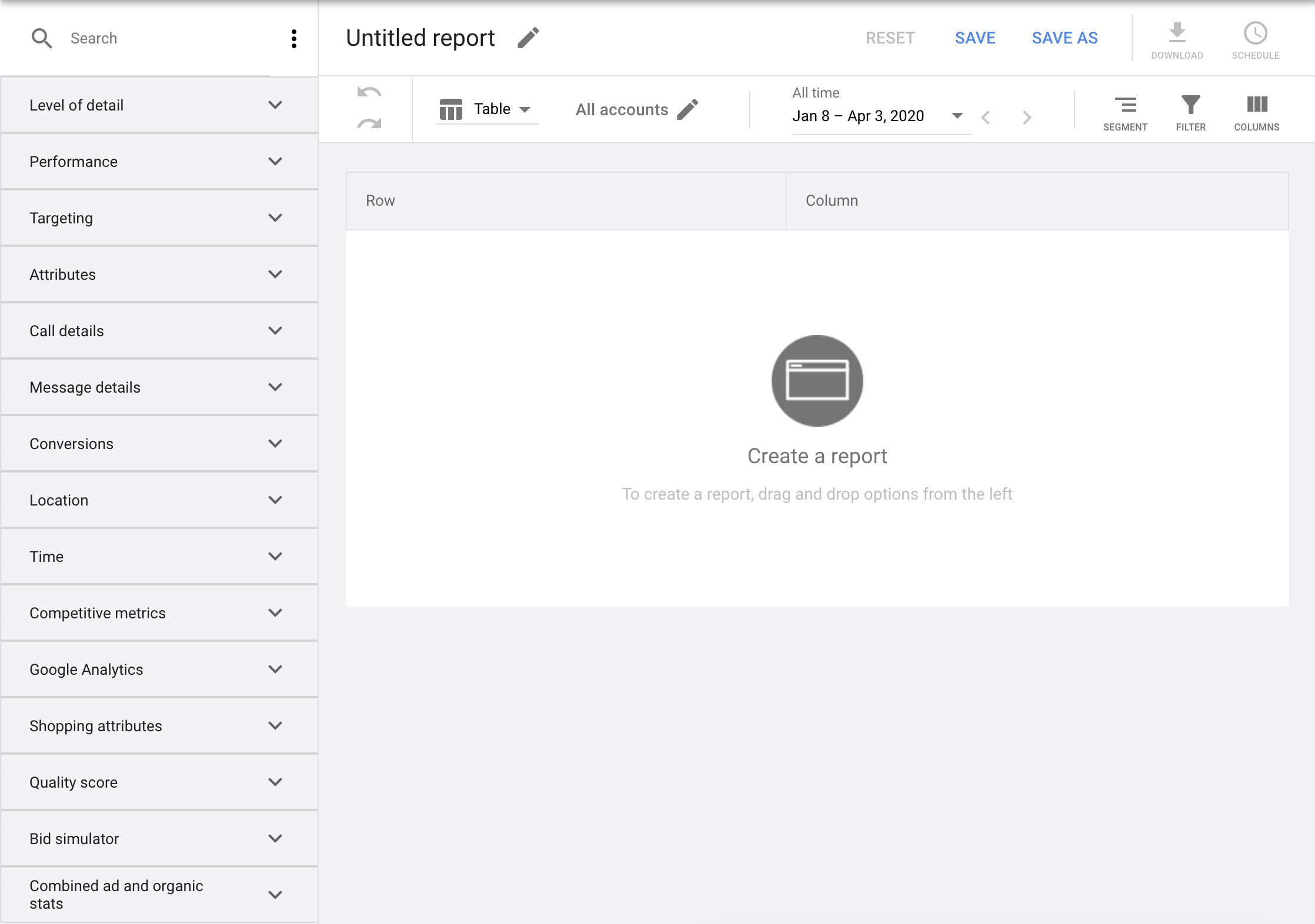
过滤
您可以过滤和整理报告中的数据。
日期范围
Google Ads 界面中有一个表格,用于显示账号统计信息,还有一个下拉菜单,用于控制这些统计信息的日期范围。

在 GAQL 中,您可以通过在 GAQL 查询的 WHERE 子句中过滤 segments.date 来实现相同的控制。
过滤条件
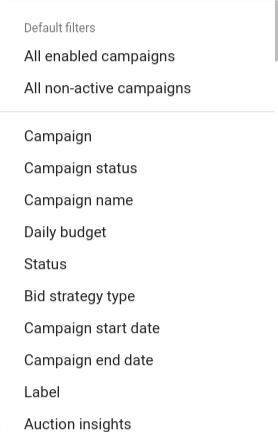
界面中的过滤条件相当于 GAQL 的 WHERE 子句中的一个或多个条件。
细分
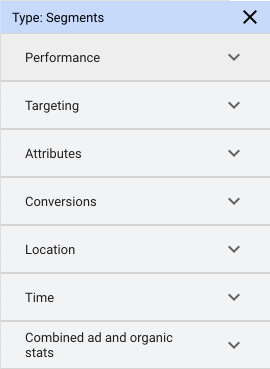
如需查看更详细的统计信息,请按细分受众群拆分数据。例如,假设您想分别查看 Google 搜索网络和 Google 展示广告网络的展示次数。在这种情况下,请按媒体资源网细分报告。如需了解如何在 SELECT 子句中添加细分字段,请参阅细分。
分页
您可以使用每个数据表格底部的控件在界面中浏览报告,这些控件可让您切换页面,并从一组预定义的大小中选择要显示的结果数量。

通过 next_page_token 使用 GoogleAdsService.Search 检索报告时,可以对结果进行分页。如需提取整个结果集而不进行任何分页,请使用 GoogleAdsService.SearchStream。
对结果排序
在界面中,您可以通过选择列来对结果进行排序。
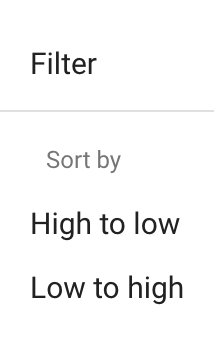
在 GAQL 中,您可以使用 ORDER BY 子句和 LIMIT 子句对查询结果进行排序。
下载格式
在界面中,报告可以下载为各种格式,例如 CSV、TSV 或 XML。
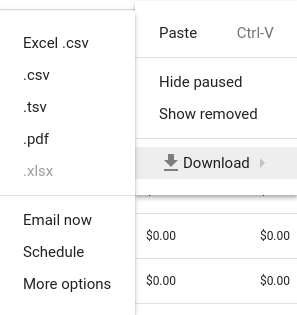
该 API 不直接支持输出中的不同格式,因此您必须执行一些后处理。请参阅此代码示例,了解如何在客户端中实现 CSV 格式设置。
定期生成报告并通过电子邮件发送
您可以在界面中安排报告的生成时间和通过电子邮件发送报告,但这些功能在 API 中不受支持。
预定义的报告
您可以在 Google Ads 界面中创建预定义报告的列表。
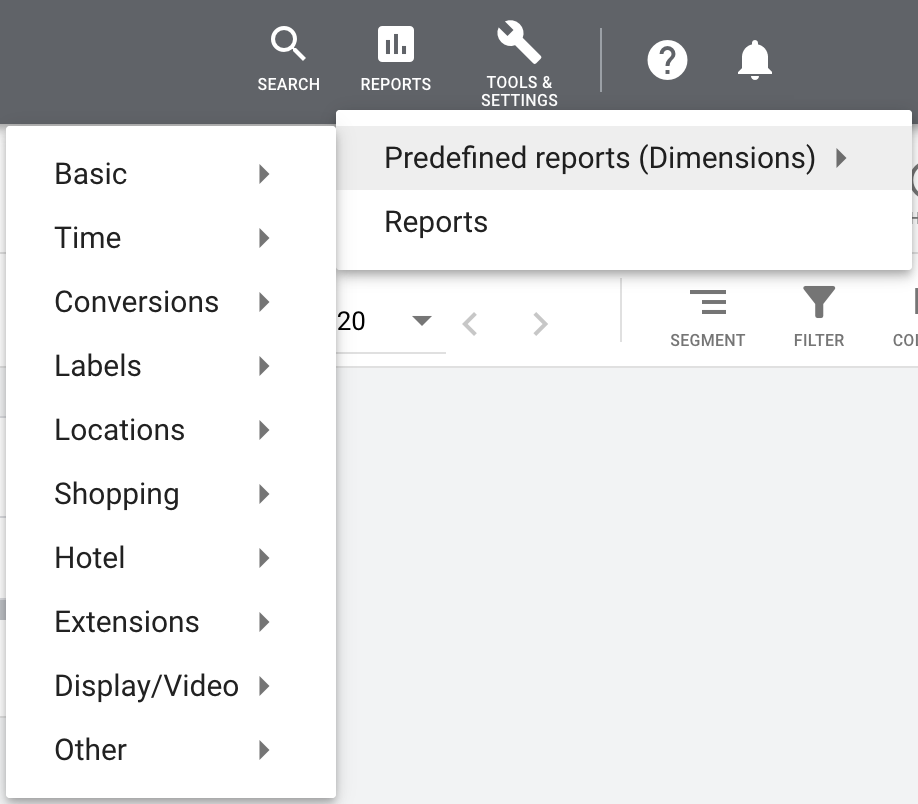
下面列出了基本预定义报告及其对应的 GAQL 资源名称。
| 基本预定义报告 | GAQL 资源名称 (在 FROM 子句中指定) |
|---|---|
| 账号 | customer |
| 广告系列, 广告系列详细信息 |
campaign |
| 广告组, 广告组详细信息 |
ad_group |
|
广告, 最终到达网址 |
ad_group_ad |
| 搜索广告关键字 | keyword_view |
| 搜索字词 | search_term_view |
| 付费渠道和自然渠道 | paid_organic_search_term_view |
| 着陆页 | landing_page_view |
| 扩展后的着陆页 | expanded_landing_page_view |
以前面表格中的示例为例,您可以使用以下 GAQL 生成账号报告:
SELECT
customer.descriptive_name,
customer.id,
metrics.clicks,
metrics.impressions,
metrics.ctr,
metrics.average_cpc,
metrics.cost_micros,
metrics.absolute_top_impression_percentage,
metrics.top_impression_percentage,
metrics.average_cpm
FROM customer
WHERE segments.date DURING LAST_7_DAYS
常见差异
将界面报告与 API 报告进行比较时,最常见的差异之一是界面会隐式过滤掉已移除的实体,而 API 不会。
为了复制默认界面视图,您需要添加一个过滤条件(通常使用 status 字段)来排除已移除的行。例如:
SELECT campaign.name
FROM campaign
WHERE campaign.status != "REMOVED"

